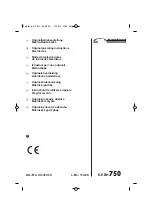
TAEevo015÷351
5
MAINTENANCE AND OPERATING MANUAL
Chapter 2 - Safety
The data inside this manual are not binding and they can be modified by the manufacturer without notice.
All rights reserved.
TAEevo015÷351
C
HAPTER
2
S
AFETY
This machinery was designed to be safe in the use for which it was planned provided that it is installed, started up and maintained in accordance
with the instructions contained in this manual. The manual must therefore be studied by all those who want to install, use or maintain the unit.
The machine contains electrical components which operate at the line voltage, and also moving parts.
It must therefore be isolated from the electricity supply network before being opened. Maintenance operations involving work inside the machine
must be performed by skilled and adequately qualified personnel equipped with suitable protection means (active and passive, e.g. work gloves)
ton ensure work in maximum safety. Do not allow extraneous persons (such as children) where the machine is installed.
2 . 1
G e n e r a l
When handling or maintaining the unit and all auxiliary equipment, the personnel must operate with care observing all instructions concerning
health and safety at installation site.
ATTENTION
Most accidents which occur during the operation and maintenance of the machinery are a result of failure to observe basic safety rules or
precautions.
An accident can often be avoided by recognising a situation that is potentially hazardous.
The user should make sure that all personnel concerned with operation and maintenance of the unit and all auxiliary equipment have read and
understood all warnings, cautions, prohibitions and notes written in this manual as well as on the unit.
Improper operation or maintenance of the unit and auxiliary equipment could be dangerous and result in an accident causing injury or death.
We cannot anticipate every possible circumstance which might represent a potential hazard.
The warnings in this manual are therefore not all-inclusive.
If the user employs an operating procedure, an item of equipment or a method of working which is not specifically recommended, he must ensure
that the unit and auxiliary equipment will not be damaged or made unsafe and that there is no risk to persons or property.
Any improper use of the machine will relieve the manufacturer from any liability for possible personal injury or property damage.
Arbitrary modifications made to the unit will automatically invalidate all forms of guarantee provided by the manufacturer.
ATTENTION
The hot / cold water produced by MTA units cannot be used directly for domestic hygiene or food applications. In the
case of such applications, the installer is responsible for fitting an intermediate exchanger.
If the intermediate exchanger is not fitted, the installer should affix a notice stating "non-drinking water".
2 . 2
L i q u i d s o f t h e u s e r c i r c u i t
The liquids of the user circuit must be compatible with the materials used. These can be water or mixtures of water and glycol, for example.
Additives and glycol suppliers must guarantee compatibility with the materials. For further information refer to 4.10 “Materials in contact with
the liquid to be cooled” .
ATTENTION
If the liquids of the user circuit contains dangerous substances (e.g. ethylene glycol) is very important to collect any liquid which leaks
because it could cause damages to the ambient. Furthermore, when the chiller is no longer used, dangerous liquids must be disposed of by
firms specialised and authorised for treating them.
2 . 3
L i f t i n g a n d c a r r i a g e p r e c a u t i o n s
Avoid injury by using a hoist to lift heavy loads.
Check all chains, hooks, shackles and slings are in good condition and are of the correct capacity.
They must be tested and approved according to local safety regulations.
Cables, chains or ropes must never be applied directly to lifting eyes.
Always use an appropriate shackle or hook properly positioned.
Arrange lifting cables so that there are no sharp bends.
Use a spreader bar to avoid side loads on hooks, eyes and shackles.
When a load is on a hoist stay clear of the danger area beneath and around it.
Keep lifting acceleration and speed within safe limits and never leave a load hanging on a hoist for longer than is necessary. The weight values
shown in the following table were obtained with the unit empty, pump P3 and axial fans.
The manufacturer does not supply bars, belts and lifting hooks with the unit.
MODEL
015
020
031
051
081
101
121
161
201
251
301
351
Weight (kg)
127
132
200
220
331
386
405
416
553
650
740
757
Weight (lb)
280
291
440
485
729
850
892
917
1219
1433
1631
1668
Table 2
W
EIGHTS









































